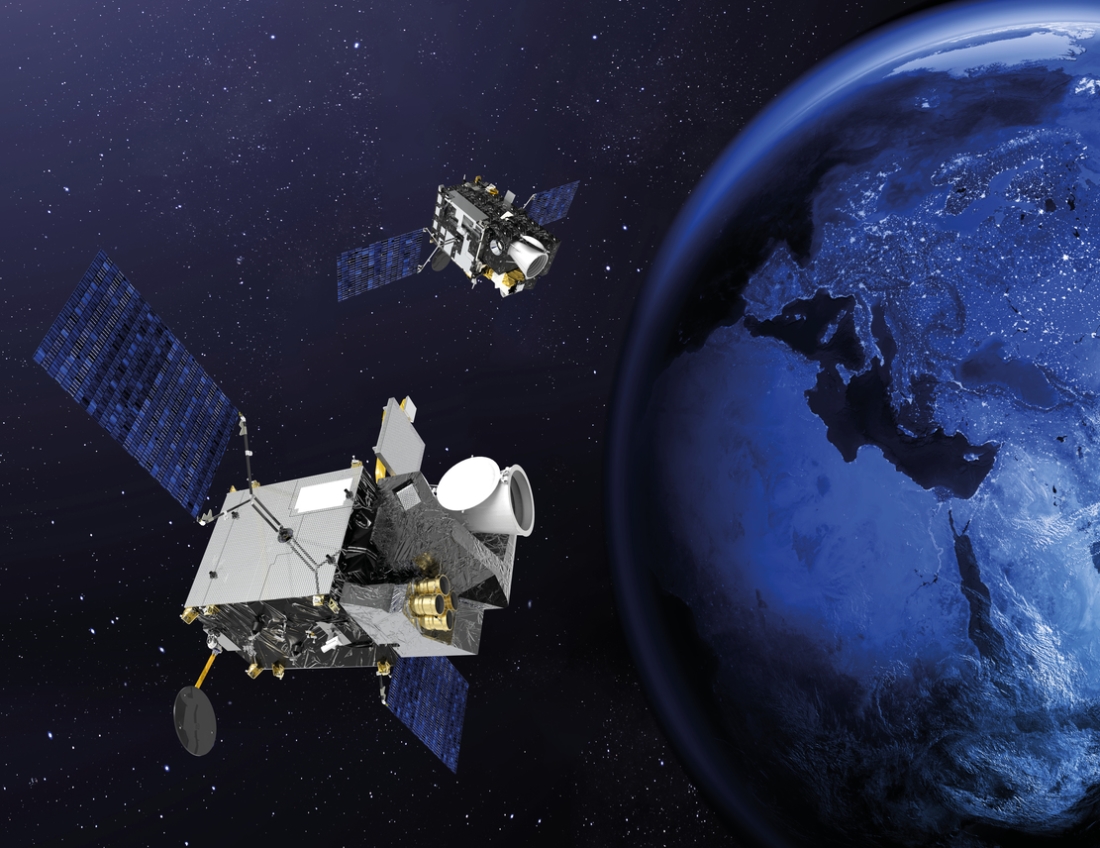A full-scale mockup of Meteosat Second-Generation weather satellites was recently installed in the gardens of the Cité de l’espace, in Toulouse. The MSG mockup is an impressive 3.20 meters in diameter and 2.60 meters high, weighing in at 300 kilos. Including its pedestal, the satellite replica stretches nearly 4.3 meters tall.

The eventful life of an exceptional mockup

The public first got a glimpse of the full-scale MSG replica at the Nice airport in October 2004. Suspended from the ceiling, the mockup graced the airport until November 2016. French film buffs can see the MSG mockup in the movie l’Arnacoeur, directed by Pascal Chaumeil, as the two stars, Romain Duris and Vanessa Paradis, walk through the airport at the end of the film.
It was then stored in Paris until this year, when it was trucked to Toulouse on August 17, 2020. After being reassembled, which took two days, the MSG mockup was installed at the Cité de l’espace on August 20. It took three cranes to carry out the requisite maneuvers – a very touchy operation as it turned out, because it had to contend with major wind gusts while still hoisted in the air.

However the crane operators were real pros, and managed to accomplish their mission as they braved the elements. In addition to a very sturdy pedestal of stainless steel, the Cité de l’espace also placed the entire assembly on a 2-ton concrete slab to make sure it doesn’t try to lift off like its real counterpart!
If you’ve always wondered what those mysterious weather satellites actually look like, treat yourself to a trip to the Cité de l’espace to see an identical twin of Europe’s own MSG… you’ll be impressed!

The Cité de l'espace also has a permanent exhibition area entirely dedicated to meteorology. This "Weather Centre" is equipped with interactive equipment, models and teaching aids that will enable you to know everything about weather forecasts. A forecaster from Météo-France is also permanently present to answer questions from the public and perform demonstrations in real time, thanks to satellite images. Click here for more information.
What’s the weather going to be tomorrow?

That’s one of the most popular online searches of course. We all want to know what type of weather awaits us. And we do have a pretty good idea of what lies ahead, thanks to the MSG satellite family. From 2002 to 2015, Arianespace successfully launched four MSG satellites, built by Thales Alenia Space as prime contractor on behalf of the European Space Agency and Eumetsat. The Seviri instrument on all Meteosat first and second generation satellites was built by Airbus Defence & Space.

These cylindrical spin-stabilized satellites operate in geostationary orbit. Everybody who’s seen them up close at our plant in Cannes can tell you that they are impressive birds indeed, with a very characteristic look. They are more than just a hi-tech jewel – you could even describe them as a real work of industrial art.
At the forefront of geostationary weather satellites in Europe

For more than 40 years now, meteorologists have counted on Meteosat technology to give them the vast streams of accurate data needed for their weather forecasts. Furthermore, between the first and second generations of Meteosat, they can also call on some 40 years of data to ensure the accuracy of their immediate and short-term forecasts.
Meteosat Second Generation satellites have a coverage zone spanning Europe, the North Atlantic and Africa, with image updates every 15 minutes as opposed to 30 minutes for the first generation. MSG also brought higher-quality images because of a significant increase in the number of observation channels, coupled with better radiometric performance and short revisit cycles. This capability allows them to detect and monitor special events such as storms, which could have a disastrous impact on a wide range of sectors, including agriculture, fishing and transportation, especially maritime shipping.
With the upcoming Meteosat Third Generation (MTG), images will now be updated every 10 minutes. In conjunction with atmospheric sounding instruments, this will make weather forecasts more accurate than ever. All European geostationary weather satellites have been built by Thales Alenia Space as prime contractor. The MTG family, comprising four imaging and two atmospheric sounding satellites, will be built in collaboration with OHB.
Stay tuned for more space chronicles from Thales Alenia Space!
Photo copyrights: ©Thales Alenia Space - ©Thales Alenia Space/Imag[IN] - ©Thales Alenia Space/Master Image Programmes - ©Cité de l'espace/F. Seroussi


